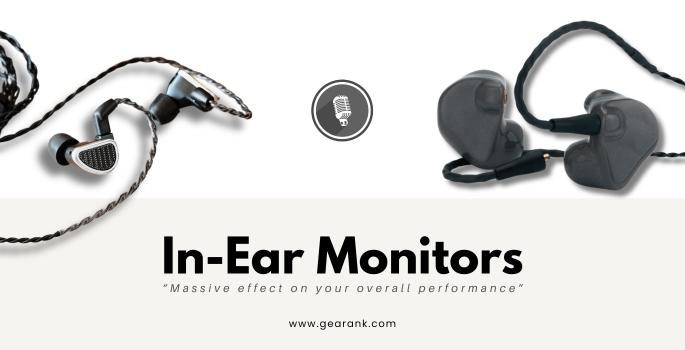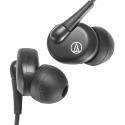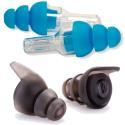What are In-Ear Monitors and Why Should We Use Them?

More and more musicians are switching to in-ear monitors, prompting the growing question we will answer in this article - what are in-ear monitors, and are they better than traditional stage monitors?
In-ear monitor systems have seen a huge rise in popularity in recent years, from smaller house of worship venues to sold-out concert arenas.
The convenience and personalized mixes they provide are good enough for professionals to swap out the feel of having an actual speaker monitor on stage.
Today, I'll discuss in detail what these devices are and how they can change your playing experience.
In-ear monitors may be tiny, but they can have a massive effect on your overall performance. Read through the end to find out how this tool can greatly improve your performance and why they are a staple of modern, high-level live performances.
Origin of In-Ear Monitors
In-ear monitors were first conceptualized by Stephen Ambrose back in the 1960s. His experiment involved swimmer earplugs and small speakers mixed with clay. He successfully completed his design in 1965, giving birth to the first-ever high-fidelity sound that could be delivered straight into a tightly sealed ear canal.
Through his years of touring with various artists such as Simon and Garfunkel, Stevie Wonder, the band Rush, and more, Ambrose was able to perfect his design. After commercializing his design, Ambrose became the only source of wired in ear monitors sold for the professional market, which lasted for over a decade.
Stevie Wonder, one of the earliest famous adapters of in-ear monitors, used a custom in-ear system on his 1980 "Hotter Than July" tour. After this, other musicians began to follow and incorporate in-ear monitors into their tours.
Some examples of this are from the 1980s, including Van Halen and The Who. So by the 1980s, in-ear monitors had become a common sight on stages around the world.
As technology has continued to improve, so too have the capabilities of in-ear monitors. Today's models include great sound quality, wireless connection, flexibility, and noise isolation. This is what makes them an essential tool for professional musicians.
What Are In-Ear Monitors?
An in-ear monitor, IEM, or simply in-ears, is an audio monitoring device used in a variety of sound applications. It delivers a personal mix of your vocals and instruments in a live performance or a studio recording.
Aside from musical performances, they're also used by audio techs and producers to give instructions to musicians, TV presenters, and other performers.
IEMs consist of three main parts: the earpiece, the driver, and the cable. The earpiece is the part that rests inside the ear canal and is most often made from a soft, pliable material.
The cable is the section that connects the earpiece to the driver, it carries the audio signal to the earbuds. The driver (or speaker) is responsible for converting the electrical signal from the soundboard or mixer into an audible sound.
An IEM has a similar look and fit to earphones. They can also be wireless and receive signals from a transmitter.
However, what sets an in-ear monitor apart from a regular earphone is its function and performance. The in-ear monitor sends a direct feed to your ears for monitoring use, taking the job of wedge monitors, while reducing stage noise and allowing for personalized mixes.
Why Use In-Ear Monitors?
Light Weight: Because of their size, in-ears are very easy to carry and set up. Compared to their larger wedge counterparts, musicians and venues can really save on floor space and weight.
Clearer Monitor: The main reason why in-ear monitors are great is how they can be personalized. Since they are quiet, musicians have personal control over their monitor mix without messing up someone else's mix.
With in-ear buds, you can set up your monitor mix to only hear what you want to hear, at the levels that are comfortable to you. This allows you to hear what you are playing clearly and have all the important reference sounds for keeping time and pitch. So you can focus on your performance without distracting, or getting distracted by your bandmates playing.
For example, bassists can emphasize the kick drums in their mixes, while guitar players can bring their guitar playing upfront for detailed sound monitoring and better clarity, something that you can't do in a small stage set up with a few floor wedges
Receive Instructions: Another advantage of quiet monitors is they can be used for internal communication. Music directors and techs can provide instructions to musicians. They can even insert a click track for strict timing. Having EIMs provides a means of communication that is discreet and efficient. This is an important advantage that is leveraged widely in TV presentations and similar events.
Loud Stage Monitors: Furthermore, this setup eliminates other issues arising from wedge monitors, like loud stage volume and microphone feedback.
We always want to hear our voice or play while on stage. If you're using a stage monitor, you tend to set your volume higher than the others. However, because everyone wants their mix to be the loudest, this causes an unpleasant stage volume. Prolonged exposure to loud sounds causes damage to your ears, plus it's disturbing for performers.
Sound Isolation: Lastly, with its isolated sound, you block out ambient noise, allowing you to zero in on your sound and playing.
Things You Often Hear From an In-Ear Monitor Mix
-
Mix of the vocals and instruments playing.
-
Stage cues and other instructions from producers.
-
Click-track or metronome.
-
Backing tracks (if used)
-
Some artists want some Ambient sound in their monitor mix (this feature is commonly seen in the best IEMs).
How To Use In-Ear Monitors
Using in-ear monitors requires a different approach than using traditional stage monitors. Here are the steps you need to take to use in-ear monitors effectively during a performance.
-
Choose The Right In-Ears
One of the first things you need to do is choose the right IEMs for your needs. Make a list of the most important elements of your performance.
Consider stage noise, sound isolation, comfort, and your budget. By laying these out, you'll ensure that you select the right piece of gear for you and/or your band.
-
Select The Right Fit For Your Ear Canal
Ear monitors are supposed to be worn, so selecting the right fit is crucial when choosing your gear. If the earpieces don't fit you correctly, then you won't be able to have good sound quality or noise isolation.
Some IEMs come with interchangeable tips. Custom in-ear monitors have molded earpieces to ensure the most comfortable and secure fit for you.
Note: noise isolation vs noise cancellation. Noise isolation blocks out outside noise and ensures only you can hear from your device. Noise-canceling is an active function requiring a battery to operate. It picks up the low-level outside noise from your environment and cancels most of it out.
-
Connect Your IEMs
Next up, you're going to need to connect your in-ear monitors to a monitor system. These typically consist of a wireless receiver or a wired connection to a mixer or other audio source.
-
Adjust Your Levels
The next step is to adjust the various channels to get the mix that sounds best to you. You want great-sounding audio that delivers a clear mix to your ears while not being too loud to avoid ear fatigue. It's ideal to check this during a sound check. Just ensure you're playing like you would in an actual performance. This allows you to go beyond the generic band mix that limits floor wedge monitors.
In-ear monitors provide the highest level of sound isolation. Because of this, wearing them for extended periods causes ear fatigue or, in worse cases, hearing damage, so it's better to set them properly, and rest your ears from time to time. Some wired and wireless IEMs have volume control which gives you direct control of the overall volume right on the receiver. Be familiar with its location, so you can quickly lower the volume when needed. -
Test Your Sound Quality
You need to make sure that you properly test your sound before performing. This is usually done during the final stages of a sound check. Aside from good volume balance, work with the monitor engineer to get your stereo mix sounding good in terms of tone.
-
Take Care of Your IEMs
To ensure that your IEMs, especially the custom ones, remain in good condition and can be reused without any problems, it is crucial that you take proper care of them.
What Are The Different Kinds of In-Ear Monitors?
You should know that there are two main kinds of in-ear monitors. The first is universal-fit monitors, which are pre-molded and designed to fit most people's ears. They come in a variety of shapes and sizes to accommodate different ear sizes and shapes.
Custom-fit IEMs, on the other hand, are all made to fit the exact shape of a person's ear. They require an impression of the ear to be taken by a professional audiologist, which is then used to create a custom mold for the IEM.
Universal fit IEMs are generally much less expensive than custom fits, but they might not fit as snugly or provide as good of a sense of sound isolation. Custom-fit IEMs are more expensive but offer better audio quality, background stage noise isolation, and comfort.
These days, wireless in ear monitors systems are in demand, because of the untethered convenience that wireless systems provide. Just clip the IEM receiver to a guitar strap or belt (if using a belt pack) and you're good to go. While the transmitters typically sit at a distance with a good wireless signal where sound waves can pass through uninterrupted. Each band member needs only one transmitter to get their monitor mix, which is controlled by the audio engineer.
Final Thoughts
The question "what are in-ear monitors" is often asked by musicians and audio monitor engineers who are looking for ways to improve stage sound and monitoring.
And rightly so, since more and more professionals are making the switch to the convenience, flexibility, and quiet operation of In-Ear monitors.
Since you don't need to stand close to floor wedges, IEMs give you the freedom to move around and interact better with your audience.
Another common use of IEMs is incorporating click tracks, which helps band members synchronize better. This is a huge plus, especially for drummers and bassists, and for bands who play with backing tracks.
Music directors and producers can also utilize the quiet operation of IEMs to coordinate with the hosts and performers, to create a smooth flow in your shows.
It's amazing how this small device has such a huge impact, transcending the usual function of commercial earphones. Incorporating these into your setup is a must if you're want lower stage volume and you're dealing with monitor mix problems.
Frequently Asked Questions
Can You Communicate with Others Through an In-Ear Monitor?
Another convenient function that an in-ear monitor brings is the ability to communicate with your team. By placing a microphone onstage with a talkback function, you can talk with your team.
It is especially useful if you have something you want to change on the spot.
It would also provide for cool on-stage moments. For example, even if the stage is pitch black, everyone still manages to play at the exact time. That's all thanks to the talkback mic and in-ear monitors.
What Is the Frequency Range For An In-Ear Monitor?
Most IEMs have a frequency range between 20 Hz and 20 kHz. However, this frequency range varies from model to manufacturer.
What Are Floor Monitors?
Floor monitors are a more traditional style of stage monitor. They project sound outward onto the stage, allowing performers to hear themselves. Since they are loud, they add to the overall stage volume. But they provide a more natural feel as the sound moves air and vibrates with the floor, and room acoustics play an important role. This is the same principle that differentiates studio monitors vs speakers, where monitors offer fidelity and clarity, while consumer speakers focus on sound enhancements.
Do In-Ear Ear Monitors Offer Ear Protection?
In-ear monitors provide some level of ear protection by blocking out external noise and helping to reduce ear fatigue. They also offer a considerable amount of background noise reduction.
Can In-Ear Monitors Be Used With A Mixing Desk?
In-ear monitors can be used with a sound desk to control and adjust the sound levels and effects of the mix. This allows performers to hear an individual mix that can be adjusted throughout a performance.
Contributors:
- Jerome Arcon - Co-writer
- Jerry Borillo - Illustrator












